Speak To Our Namibia Expert Today
and start planning your tailor-made holiday

Richard
Travel Expert
Find out where to explore in Namibia

Namibia is a country unlike anywhere else in Africa, with its extraordinary landscapes, vast isolated parks, and a sense of solitude rarely found in our busy modern world. It has a beautifully desolate appeal, and perfect for those who prefer their holidays to come with a good dose of peace, and a slice of the unusual.
So which are the best places to visit in Namibia?
The first thing most people think of when Namibia is mentioned isn’t animals or safaris. It’s sand dunes. And for good reason too. Sossusvlei is a vast white salt pan surrounded by spectacular red dunes, some of which are the highest in the world at nearly 400 metres.
Hidden away in the Namib-Naukluft National Park, Sossusvlei is the most popular sight to visit in all of Namibia. It is usually dry throughout the year, but occasionally during periods of unusually high rainfall the salt pan fills with water creating mesmerizing reflections of the neighboring dunes.
Big Daddy
Standing at 380m Big Daddy is the highest dune in the area, and sits between Sossusvlei and Deadvlei. Climbing to the top is hard work but worth it just to see the sun rising over the endless sea of dunes that stretch out towards the horizon. There is also a great view of Deadvlei from the summit.
The full climb takes most of the morning, so many visitors elect to ascend only to the first ridge before descending to explore the Dead Vlei salt pan.
Getting there
The park gate opens at dawn, and usually a number of vehicles will already queuing in the dark to ensure they can be first through the gate and onto the road that leads through the avenue of dunes to Sossusvlei.
Once inside the park, there are two parking areas here, one for non- 4x4 vehicles which you come to first. From there you can either walk 4km down to Sossusvlei or pay for the shuttle transfer down there. Drivers in 4x4 vehicles can drive down to an additional parking area and from there it is an easy walk to start climbing the dunes.
Deadvlei
You’ll have seen pictures of Deadvlei in art shops, travel magazines and online, as it’s probably the most photographed spot in the country. The clay pan is home to several dead camel thorn trees, their darkness a striking contrast to the dunes around them and the white floor of the pan. These trees have been here for 900 years, little changed thanks to the arid climate which has preserved them.
At 50,000 km² the Namib-Naukluft Park is the largest conservation area in Namibia, and indeed one of the biggest in the world. It stretches between the central Namibian plateau across to the Namib Desert, and is characterised by vast open spaces, imposing mountains, and stunning eco-lodges which offer experiences such as quad biking, hot air ballooning and horse riding. It’s in this park where you’ll also find the Namib Sand Sea, a UNESCO World Heritage Site famous for being the only coastal desert where the nature of the dunes is determined by fog.
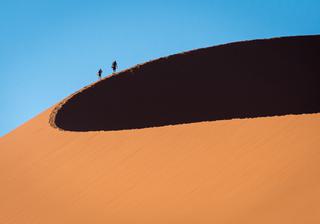
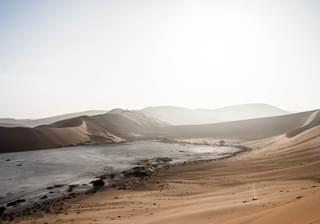
Of course, you can’t come to Africa and not factor in a bit of wildlife viewing, and luckily Namibia does this really well too.
The malaria-free national park is an impressive 27,000 km², named after the giant shimmering silver salt pan in its midst, with vast plains, waterholes, woodlands and grasslands just waiting to be explored.
Etosha is one of the richest game reserves on the continent, and the place to go if you want to clap eyes on lion, black and white rhino, giraffe, cheetah and a host of other plains animals. Its numerous waterholes formed around an ancient salt pan make seeing elephants almost inevitable, especially during the winter months. There are also over 340 species of birds here too, so don’t forget your binoculars.
When to visit Etosha? Whilst Namibia is one of those countries with year-round appeal, Etosha is best visited during the dry season between July and October if you want to be in with a chance of seeing much wildlife. After October the extreme heat can become oppressive and the rains begin, so it’s best to avoid this period up until March.
To find out more about visiting Etosha, take a look at our complete guide.

Nestled away on the coast, the quaint Germanic seaside town of Swakopmund is a stopping point for almost all visitors to Namibia, breaking the journey between Sossusvlei and Damaraland, as well as being an excellent staging post for self-drivers looking to explore the renowned Skeleton Coast.
Beloved by Namibians looking to escape the heat of the country’s interior and enjoy the cool sea breezes, Swakopmund has a laid-back resort-town feel to it and boasts an excellent selection of restaurants, cafes and bars. The German influence on the town is unmistakable, with the streets dotted with Bavarian-style buildings, hotels bearing German names – Hotel Zum Kaiser – and bars with marvellously moustached barmen serving frothing steins of Pilsener. As you’d expect from a holiday town, there are a wide arrange of restaurants, with seafood featuring prominently. The Tug (the-tug.com) is a Swakopmund highlight and well worth seeking out… though an advance booking is a pre-requisite.
Top activities
Sea kayaking – Head down to Walvis Bay, about an hour south of Swakopmund and kayak with Cape Fur Seals on Walvis Bay Lagoon. The trip includes a drive along the sand spit that extends to the south of the town and creates the lagoon, with the chance to spot animals such as black-backed jackals scavenging on the beach
Catamaran cruises – A wonderfully genteel way to spend a day; take a trip down the coastline in a catamaran, marvelling at the dunescape that leads from the desert right down to the water’s edge. Food and drink are taken along so you can really make a day of it.
Quad biking in the dunes – explore the sea of dunes surrounding Swakopmund astride a quad bike. With spectacular views down the town and desert beyond…this is an exhilarating way to spend half a day, and usually includes a chance to sandboard down some of the larger dunes.
Living desert tours – To the amazement of some and disbelief of others, the deserts surrounding Swakopmund support a remarkably wide array of animal and plant life. Chameleons, snakes, lizards, and spiders are all found in the desert, along with the remarkable Welwitschia plant
Skydive Swakopmund – For the ultimate adrenaline rush, soar into the skies on a specially adapted aircraft before taking a leap of faith strapped to an experienced instructor. Free fall at 200kmh before your parachute opens and you spend approximately 7 mins descending over the oldest desert in the world.

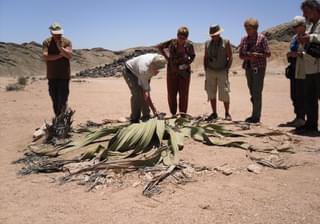
Continuing the theme of vast, ancient and isolated, Fish River Canyon is the place for avid hikers to come for a multi-day adventure and some alone time with nature. The canyon is the second largest in the world and at 160km long its rugged interior is very little visited. There are hiking trails along the rim offering spectacular views, and for the more intrepid and totally self-sufficient explorer, there is the 90km long Fish River Canyon Trail.
The most popular time to visit the canyon is Namibia’s winter between May and September. The cooler temperatures mean that the hiking trails through the canyon open for business. These trials are on marked routes through the canyon and vary in length and the degree of fitness they require, with some of them taking up to seven days.
The trails really are an alluring prospect. Imposing views from the canyon floor, swimming in the cool waters of the Great Fish River, stargazing in the clear night skies and some of the most glorious campsites imaginable make this one of Namibia’s most sought-after and rewarding adventure experiences.
As temperatures start to soar in October (reaching upwards of 45°C) the hiking trails close, remaining so until April. However, this doesn’t automatically mean Fish River Canyon needs to be discounted from travel plans…. traveling in this hotter period sees the focus of activities shift towards shorter excursions such as guided drives in the cooler parts of the day, shorter walks on the canyon trim and biking trips. It is also still possible to get down into the canyon base – usually with the help of a 4x4 both ways or at the very least for the return journey.
Where to stay: Fish River Lodge
Spectacularly located right on the edge of the canyon, Fish River Lodge is run by Journeys Namibia and consists of twenty luxury chalets with unparalleled canyon views and wonderful privacy on the western side of the canyon.
Spend your days walking, mountain biking or relaxing in the infinity pool. In the evenings, watch the sunset from your private verandah or stargaze from your bed thanks to the floor-to-ceiling windows.
Fish River Lodge is the only accommodation from which you can do a guided hike (fully inclusive) in the canyon itself and to swim in its rockpools. Choose between day trips, or longer trails where you’ll glamp in different gabion stone shelters each night and dine under a thousand stars.
The lodge also operates the only access route by vehicle into the Fish River Canyon. Day trips take you into the depths of the canyon to witness first-hand the millions of years of geological upheaval. Lunch is served at a set of permanent rock pools before return to the lodge.

Damaraland is often overlooked by visitors in favour of nearby Etosha, and as a result it’s a fascinating and uncrowded area to explore, full of rocky mountains, grassy plains and unique wildlife. Here you’ll find desert elephants and the iconic oryx as well as lions and leopard, and it’s even possible to go black rhino tracking by foot.
Rhino Tracking
How it works: Rhino tracking is usually done in the early mornings when it is cooler and the rhinos are at their most active, feeding and drinking before seeking cover from the heat of the day. Accompanied by qualified guides (who also act as anti-poaching ‘guardians’ for the rhinos in their particular concession) – excursions set out on foot navigating the arid, rock-strewn terrain in search of the rhino, with many other species also likely to be encountered as you go. Once sighted at close quarters, it is one the most exhilarating experiences imaginable - without doubt one of Africa’s greatest wildlife encounters.
The plight of the rhino during the ongoing poaching epidemic is well documented, and these excursions provide a valuable chance to learn more from the rangers about the efforts being taken to protect and conserve this majestic species.
Stay at: Desert Rhino Camp, Grootberg Lodge, or Palmwag Lodge.
Take a look at our full guide to Rhino tracking in Namibia
Whilst you are here.... check out Twyfelfontein
One of Africa’s largest petroglyphs is found here at Twyfelfontein (also a UNESCO World Heritage Site), and it’s quite humbling to stand before the red ochre rock carvings and imagine them being painted by hunter-gathers more than 2000 years ago. The semi-nomadic Himba people can be found in Damaraland, living a secluded and traditional cultural lifestyle not unlike other tribes across central and southern Africa.

The Kalahari Desert is vast. It covers most of south-eastern Namibia, as well as parts of 6 other countries in southern Africa, and is the domain of gently undulating red dunes, golden grass and San hunter-gathers. We'll let you into a little secret. The Kalahari isn’t actually a desert, not in the true sense anyway, because it receives a fair bit of rain.
E-bike
Electronic bikes are all the rage these days, eco-friendly and allowing riders to cover huge distances, especially welcome in the heat of the Kalahari Desert. This is one of the best spots in all of Africa to enjoy e-biking trails, zipping through the rolling sea of red sand dunes and marveling at the stunning landscapes. As you ride guides will point out the varied wildlife you see, including oryx, springbok and ostrich, as well as help identify the sign of the more secretive cats, both big and small that live their elusive lives in the desert. They really are a wonderful way to explore, sedate but exciting, with plenty to see and do as you ride through this much under-visited but rewarding part of the country
Other activities include cultral visits, ranch tours, guided San Bushmen hikes, and you might be surprised to learn you can spend time with meerkats! The suricate, better known as a meerkat, is a small mongoose found throughout Namibia, and they are easily habituated to people meaning close observation and sometimes even interaction can be possible. The Kalahari is one of the best places for this.

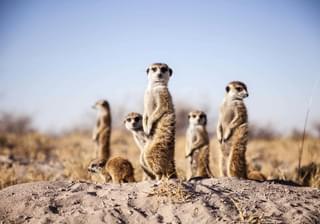
Something of a cartographic oddity – the Caprivi Strip extends out on a 450 km limb from the north east corner of the rest of Namibia. Sandwiched between Angola and Botswana, it stretches all the way to the Zambezi river, meaning Namibia shares a short border with Zambia and only falls some 100 metres short of giving it a border with Zimbabwe as well.
Away from the seemingly endless deserts that cover much of Namibia, the lush, verdant Caprivi Strip feels like a completely different world, where winding rivers, open grasslands and forests replace the stark desert plains. With abundant wildlife, especially birdlife, this is a superb area for game viewing, with the boat cruises along the Okavango River one of the most enjoyable ways to spend time here. This little-visited region includes 5 protected areas and opportunities for a safari experience similar to those in Botswana - without the same hefty price tag!
The afternoons are the best time to enjoy these, with the sun starting to dip in the sky so it is getting cooler and animals are out in the open much more. With a coolbox full of drinks and snacks taken along, these boat cruises are a wonderfully relaxing way to enjoy time in this unique part of Namibia.
Did you know you can combine it with Victoria Falls?
The Caprivi Strip finally ends at Impalila Island. Sandwiched between the Chobe and Zambezi rivers it has a range of lodges & campsites and is a good choice to start or finish an adventure through this part of Namibia.
With the Victoria Falls just an hour or so across the borders of either Zambia or Zimbabwe almost all visitors to the Caprivi will include a short stay here, and use either Livingstone or Victoria Falls International Airports as their entry/exit point

Namibia is the cheetah capital of Africa, and the Cheetah Conservation Centre (set up by Africat) in the Okonjima Nature Reserve, a gem of the Central Highlands offers visitors the chance to encounter the fastest animal in the world in a rather unique way.
Broadly speaking, Africat supports the conservation and rehabilitation of predators (mainly cheetah and leopard) who have been injured when coming into conflict withlandowners – a big issue in Namibia where none of the national parks are fenced, allowing big cats with huge home ranges the opportunity to cover many hundreds of miles in search of food. As farms expand within Namibia these conflicts have become all the more common as the larger cats prey on the comparatively easy targets of livestock.
A stay at Okonjima provides a chance to see these animals up close and personal, and to learn more about the work Africat do to help protect animals living in the wild – including education and awareness initiatives for local landowners big and small.
Guests can take part in feedings, experience the thrill of seeing the cheetahs run whilst hunting a lure, and take a game drive alongside these magnificent animals for some world-class photography opportunities.

Not far from Namibia’s foreboding Atlantic coast, a short drive from the port town of Luderitz, the old diamond mining town of Kolmanskop, long abandoned, sits as a monument to one of Namibia’s great boom and bust stories.
From a barren desert, this patch of land became a thriving community, whose wealth was built on the discovery of diamonds beneath the sands. Nowadays the buildings; old houses, hotels, a hospital and even a skittles alley are rapidly being reclaimed by the desert sands, lending an eery ghost town feel to proceedings.
Tours depart from Luderitz each morning, with guides on hand to tell the fascinating story of the discovery of diamonds, how Kolmanskop became, for a short time, one of the most prosperous places on the planet before being abandoned almost as quickly as it was discovered and left to fall in to ruin. They also sell special photography permits, allowing more wide-ranging access to the town and the chance to take some truly extraordinary photographs.
Desert Horses
The desert near Komanskop is also home to a small population of feral desert horses, numbering between 90 and 150, regarded to be the only such population in Africa. Their origins are disputed, although it is likely they are a cross-breed of riding and cavalry horses that were used in Namibia by the Germans in the early 20th century. Today they congregate around the small outpost of Aus, attracted by the permanent, man-made water found there.
Despite the harsh conditions, the horses are in very good health and only seem to struggle in times of extreme drought in the region.
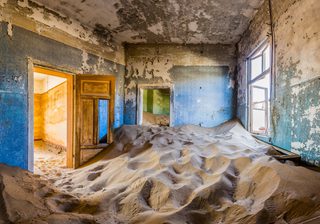

Regarded by generations of mariners as the most feared stretch of coast in the world, the Skeleton Coast was referred to by Portuguese sailors as ‘The Gates of Hell’ owing to how challenging the coast was to navigate.
When the cold sea air hits the warm air from the deserts inland it creates a bank of fog that extends out to sea for many miles. And the resulting shipwrecks that are dotted up and down the coastline are perhaps more numerous than anywhere else in the world. This wild and inhospitable stretch of coastline has become one of Namibia’s most captivating attractions – but it gives up its treasures reluctantly – there is very little infrastructure, one road in and out, and few obvious features, save the sea and endless dunes.
Guided tours/fly-in safaris: Aside from a full blown multi-day expedition, the only real way to get a complete Skeleton Coast experience is to either fly in or be transferred via 4x4 to one of the three high end lodges that operate in the area. Owing to their challenging operating environments, these come at a considerable price tag, but are able to offer a wide range of activities and such is the allure of the Skeleton Coast, they always seem to be full
Activities include quad biking adventures, game drives looking for desert-adapted wildlife among the dry riverbeds, climbing the vast dunes, and if you’re game – sandboarding down them
Where to stay: Hoanib Valley Camp or Shipwreck Lodge
In the north of Namibia, far off the beaten track lies the Kunene River and it is this area which is home to the Himba people.
The Himba people are probably the most easily recognised of Namibia’s ethnic groups. Their images are widely used to advertise the country, but their numbers (about 50,000) make up just one or two per cent of the population. They inhabit the Kunene region and lead a semi-nomadic life, keeping close to the Kunene River and the constant water source it provides.
Their homes are simple, cone-shaped structures of saplings, bound together with palm leaves, mud and dung. They breed sheep and goats, but cattle are regarded as the key store of wealth, not to mention personal and family pride.
Traditionally both men and women go topless and wear loincloths made of animal skins. The red ochre cream that the Himba women are famous for is made by pounding the ochre stone (Hematite) into small pieces. The fragments are then mixed with butter, heated using smoke, then applied on the skin and woven into hair.
Where to stay: Serra Cafema Camp
This luxury camp celebrates the culture of the Himba people by operating under a mutually beneficial partnership with the Marienfluss Conservancy (a 300,000 hectare area). This conservancy is primarily owned by the Himba people, providing income, employment, and skill transfers, whilst protecting the natural habit.
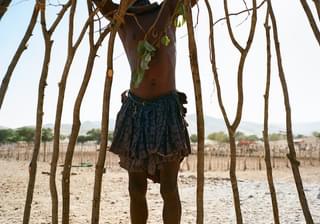
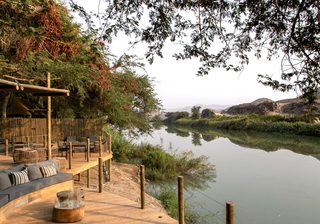
In African travel terms, the definition of the word ‘luxury’ is changing fast. Traditionally luxury travel has been all about the finest champagnes, thread counts on linen sheets, haute cuisine, private plunge pools and rooms the size of tennis courts. But nowadays where time is ever more precious, and conventional luxury more accessible to many – what constitutes luxury is evolving. The new ‘luxury’ is about having unique experiences, enjoying a sense of space… the privilege of being where others are not… and in general a more personal experience.
And it is hard to think of an experience in Africa that more squarely fits into this new framing of luxury than the Schoeman family’s Skeleton Coast Flying Safaris. Their extraordinary safaris which involve joining a small group in a private plane and flying to some of the remotest areas left in the world. Now in its second generation having been founded by the late Louw Schoeman over 25 years ago, the company is run by his four sons; Bertus, André, Leon and Henk Schoeman, who personally guide all trips. Operated in small Cessna aircraft, safaris last between 3 and 7 days and venture deep into the Skeleton Coast to places where no roads lead, ensuring the only people that share the experience are fellow guests, the pilot and camp staff. A luxury experience if there ever was one!
A typical trip involves landing the tiny aircraft on deserted beaches and rudimentary desert airstrips, driving through the dunes in old Land Rovers, exploring ancient shipwrecks and spotting wildlife that will rarely have come into contact with humans. Usually one night is spent at each location – with simple camps comprising walk-in dome style tents set underneath wooden huts, with comfortable camp beds, a small bedside table, and en-suite chemical toilets. (They do have a new semi-permanent camp – where facilities move up a notch… larger tents, proper beds, and en-suite bathrooms). Meals are eaten on tin plates on your knees by the light of a campfire, or munched leaning over the wing of a recently landed Cessna. Privileged luxurious experiences no doubt – but a far cry from the conventional ‘classic’ luxury Africa safari.
There are five separate itineraries to choose from, and in line with the Schoemans low-key approach to everything, they are simply called Safaris A, B, C, D and E. The most basic spends three nights and four days exploring the Skeleton Coast, with safaris B to E for longer durations incorporating Sossusvlei, Etosha and Kolmanskop et cetera.
The NamibRand is Africa’s first International Dark Sky Reserve and ranks among the very best places in the world for star-gazing. With the absence of any light pollution or artificial light for miles around, it has been designated a gold tier ‘Dark Sky Reserve’ – one of only two in the world.
Where to stay
Kwessi Dunes
Located deep in NamibRand Nature Reserve amongst vast rolling plains, craggy mountains and picturesque red sand dunes lies Kwessi Dunes.
Once a traditional farm, there are now 12 cool and quirky chalets complete with four poster beds and endless views. Each of the 12 chalets has a private ‘star-gazer’ room which is open to the night sky – perfect to watch the celestial theatre show above.
Set in Wolwedans, a privately operated wilderness area located within the 200,000-hectare NamibRand Nature Reserve, Dunes Lodge is perched atop the plateau of a large dune. This stunning lodge is a superb spot from which to explore the reserve with nine spacious and stylish rooms with their own private balconies, perfect for star gazing.
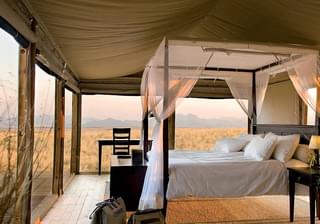
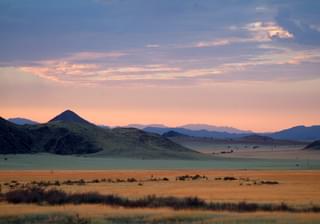
Of course, one of the day-to-day highlights of Namibia is being able to self-drive and have a real adventure – the feeling of exploring under your own steam is a truly wonderful one.
Picking up a 4x4 and hitting the open road is the best way to explore Namibia and is a huge part of what makes a trip here so special. Driving from place to place is very much part of the adventure here, with the ever-changing landscapes ensuring that no two journeys are the same. The roads are largely empty, so there is no driving through endless streams of traffic and there are plenty of places to stop for a drinks break or a picnic lunch whilst you enjoy the mesmerising views that unfold wherever you look. Self-driving also allows you to explore the many National Parks and highlights of the country such as Etosha, Damaraland and Sossusvlei without the need for hiring a guide or joining a group. Whether travelling as a couple, a family or a larger group of friends, a road trip through Namibia is a fabulous experience and one that will live long in the memory.
Wondering when to visit? Take a look at this guide on the best time to visit Namibia.
Looking for some more inspiration? Take a look at our best safari holidays ideas, our favourite family safaris, our big five safari guide or our top African safari honeymoon suggestions.
and start planning your tailor-made holiday

Travel Expert